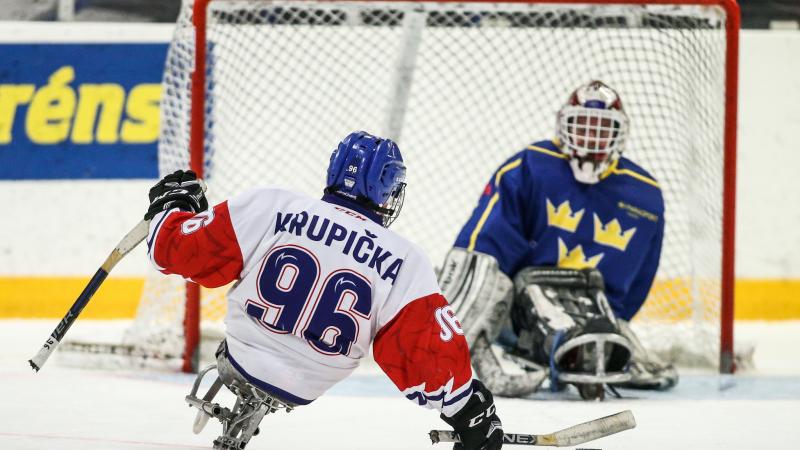
Since its debut at the Lillehammer 1994 Winter Games, the Paralympic version of ice hockey has quickly become one of the largest attractions for spectators. It is fast-paced, highly physical and played by male and female athletes with a physical impairment in the lower part of the body.
It follows the rules of the International Ice Hockey Federation (IIHF) with modifications. Instead of skates, players use double-blade sledges that allow the puck to pass beneath. Players use two sticks, which have a spike-end for pushing and a blade-end for shooting.
An 8-team tournament contested by both male and female athletes. As in ice hockey, each team attempts to outscore its opponent by shooting the puck across the ice and into the opposing team’s goal while preventing the opposing team from scoring. Six players (including the goalkeeper) from each team are on the ice at one time. Double-blade sledges that allow the puck to pass underneath replace skates, and the players use sticks with a spike-end and a blade-end. Therefore, with a quick flip of the wrist, the players are able to propel themselves using the spikes and then play the puck using the blade-end of the sticks. A player may use two sticks with blades in order to facilitate stick handling and ambidextrous shooting. Ice sledge hockey games consist of three 15-minute periods. Protective gear: Because of the physical nature of the game, all players are required to wear a helmet with a full cage or mask. Players are also encouraged to wear protective padding, including shoulder pads, shin guards, elbow pads and large padded gloves. In addition, the goalkeeper wears leg pads, large shoulder pads, a helmet with a cage, a catcher glove and blocker glove to protect the athlete from pucks flying up to 100 km/h. Puck: Made of vulcanised rubber or other approved material, the puck is 2.54cm thick, with a diameter of 7.62cm and weighs 156 to 170 grams. Sledge: Made of aluminium or steel, sledges are 80cm minimum in length with a curved front end and a seating system called a bucket (seat). The sledge is set on two blades, which are usually made of tempered steel and are each 3 mm thick. The puck must be able to pass underneath the sledge. The height of the main frame must be between 8.5cm and 9.5cm above the ice, and the length of the blade may not be more than one-third of the total length of the sledge. The sledge may be equipped with a backrest, but it must not protrude laterally beyond the armpits when the player is properly seated. Straps secure a player’s feet, ankles, knees and hips to the sledge. Stick: In Para ice hockey, players use two sticks with a hooked blade at one end (for puck handling and ambidextrous shooting) and a pick at the other end. Each stick has a maximum length of 1m and is made of carbon fibre or fibreglass. The blade has a maximum length of 32cm, except for the goaltender’s blade, which has a maximum length of 39cm.Rules and Equipment
Equipment
Documents:
Eligible impairments
| Hypertonia | Impaired Muscle Power |
| Ataxia | Leg Length Difference |
| Athetosis | Impaired Passive Range of Movement |
| Limb Deficiency |
Classification description
In Para Ice Hockey there is only one sport class. Athletes have to have an impairment in the lower part of their body that would prevent them from competing in able-bodied ice hockey.
Resources:
Ireland currently does not have a Para Ice-Hockey National Governing Body member of Paralympics Ireland
| Governing Body | |
| International | World Para Ice Hockey |
Summary
Events & Rules
Classification
Get Involved
summary
events








